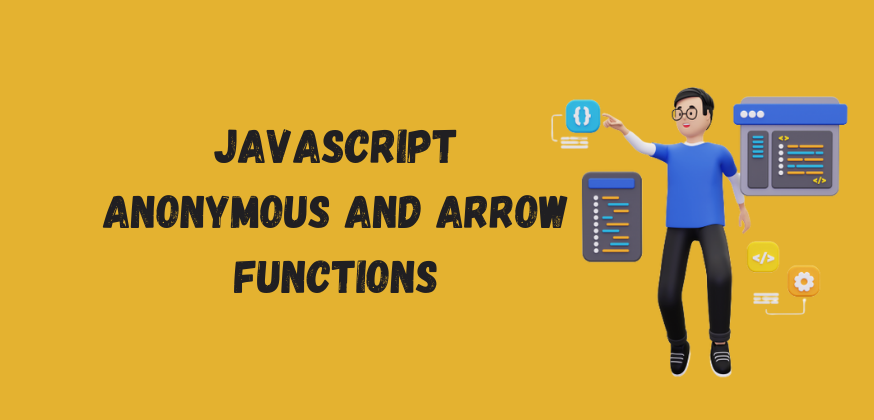Anonymous and Arrow Functions in JavaScript
 Shefali
ShefaliTable of contents

JavaScript provides various ways to define and use functions. Two commonly used types of functions are anonymous functions and arrow functions. In this blog, we will learn about these two functions in detail.
Let's get started!🚀
Anonymous Functions
An anonymous function is a function that does not have any name. These functions are often defined inline and can be assigned to a variable or passed as an argument to another function.
Anonymous functions are useful when you need a quick function definition, and there's no intention of reusing it elsewhere in the code.
Syntax of Anonymous Functions
// Anonymous function assigned to a variable
var myFunction = function() {
console.log("This is an example of an anonymous function.");
};
// Invoking the anonymous function
myFunction();
In this example, myFunction is an anonymous function assigned to a variable and you can invoke this function by using the variable name.
Use Cases of Anonymous Functions
Callback Functions
// Using an anonymous function as a callback
setTimeout(function() {
console.log("This is invoked after 2 seconds");
}, 2000);
In the above example, an anonymous function is given as an argument to another function.
Event Handlers
// Anonymous function as an event handler
document.querySelector("Button").addEventListener("click", function() {
console.log("Button clicked!");
});
When you want to attach an event handler dynamically, you can use the anonymous function.
Immediately Invoked Function Expressions (IIFE)
// IIFE using an anonymous function
(function() {
console.log("This is an example of IIFE.");
})();
If you want to create a function and execute it immediately after the declaration, then you can use the anonymous function like in the above example.
Array Methods
// Using anonymous function with array map method
const numbers = [1, 2, 3]
const doubledNumbers = numbers.map(function(num) {
return num * 2;
});
console.log(doubledNumbers); // [2, 4, 6]
You can use the anonymous functions with array methods like map, filter, and reduce.
Advantages of Anonymous Functions
Anonymous functions are often more concise in scenarios where a function is simple and won't be reused.
When anonymous functions are used in IIFE patterns, they reduce the risk of variable conflicts in the global scope.
Limitations of Anonymous Functions
Anonymous functions can decrease the code readability.
With anonymous functions, debugging can be more challenging, as they lack meaningful names.
Anonymous functions have their own
thisbinding, which may lead to unexpected behavior in certain contexts.
Arrow Functions
Arrow functions, introduced in ECMAScript 6 (ES6), provide a more concise syntax for writing functions. They are particularly useful for short and one-liner functions.
Syntax of Arrow Functions
// Basic arrow function
const add = (a, b) => {
return a + b;
};
If you have a single expression in the function body, then you can omit the curly braces {} and the return keyword as shown in the below example.
const add = (a, b) => a + b;
If you have a single parameter in the function, then you can omit the parentheses around the parameter as shown in the below example.
const square = x => x * x;
For functions, in which you have no parameters, you still need to include empty parentheses as shown in the below example.
const randomNumber = () => Math.random();
Lexical this in Arrow Functions
One of the most significant features of arrow functions is that they do not have their own this binding. Instead, they inherit this from their parent scope. This behavior can be especially helpful when working with event handlers or callbacks within methods.
const obj = {
name: "John",
greet: () => {
console.log(`Hello, ${this.name}`); // Lexical 'this' refers to the global scope, not obj
}
};
obj.greet(); // Output: Hello, undefined
In the above example, the arrow function greet does not have its own this binding, so it uses the this value from its parent scope, which is the global scope. Since name is not defined globally, it outputs undefined.
Use Cases of Arrow Functions
Array Manipulation
const numbers = [1, 2, 3, 4, 5];
// Using regular function
const squared = numbers.map(function (num) {
return num * num;
});
// Using arrow function
const squaredArrow = numbers.map(num => num * num);
Callback Functions
const numbers = [1, 2, 3, 4, 5, 6];
//Using regular function
const evenNumbers = numbers.filter(function(num) {
return num % 2 === 0;
});
//Using arrow function
const evenNumbersArrow = numbers.filter(num => num % 2 === 0);
Asynchronous Operations
const fetchFromAPI = () => {
return new Promise((resolve, reject) => {
fetch('https://api.example.com/data')
.then(response => response.json())
.then(data => resolve(data))
.catch(error => reject(error));
});
};
fetchFromAPI().then(data => console.log(data));
Advantages of Arrow Functions
Arrow functions have a more concise syntax, especially for short, one-liner functions.
Arrow functions do not have their own
thisbinding. Instead, they inheritthisfrom their parent scope.Arrow functions often result in cleaner and more readable code, especially when used with array methods like
map,filter, andreduce.
Limitations of Arrow Functions
Arrow functions do not have their own
argumentsobject.The concise syntax of arrow functions may lead to less descriptive function names, which can sometimes affect the code readability.
Arrow functions cannot be used as constructors, attempting to use
newwith an arrow function will result in an error.
That’s all for today.
I hope it was helpful.
Thanks for reading.
For more content like this, click here.
You can also follow me on X(Twitter) for getting daily tips on web development.
Keep Coding!!
Subscribe to my newsletter
Read articles from Shefali directly inside your inbox. Subscribe to the newsletter, and don't miss out.
Written by

Shefali
Shefali
I am a passionate web developer from India. I find pleasure in talking about programming and I love to help everyone who needs any guidance related to programming.